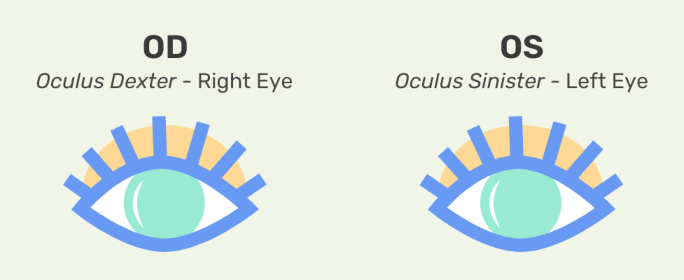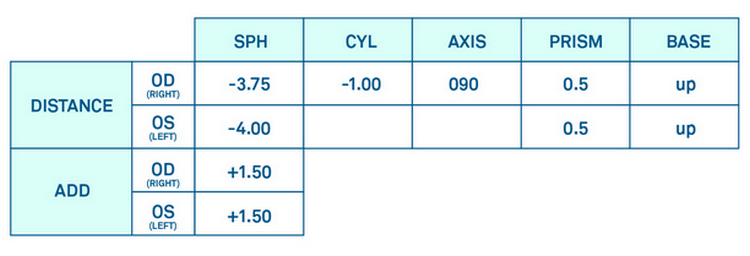- Eyeglasses
- Glasses
- Shop By Frame
- Shop By Style
- Featured
- Premium Selection
- Sunglasses
- Kids' Glasses
- Readers
- Shop By Lens
- Promium Selection
- Accessories
- My Orders
- Order Tracking
- Blog
- Have a Question?
- E-mail:cs@efeglasses.com

Your eye prescription will indicate to you what kind of contacts or glasses you require and how well you can see. Although many people find these phrases perplexing, understanding their meanings will improve your understanding of eye care. However, some abbreviations like OD and OS may appear when you look at your prescription. To make it easier for you to choose the right glasses or contacts, let's examine these terms and their importance for your eye health.

Understanding Eye Prescription Basics
Similar to a recipe for contacts or glasses, an eye prescription is a note from your eye doctor outlining what you need to see better. It is crucial for helping the visually impaired because it ensures that the maximum amount of vision correction is achieved through your contacts or glasses.
In addition to OD and OS, phrases like "sphere," "cylinder," and "axis" are also present in an eye prescription; these terms tell the lens or contact manufacturer how best to shape the lenses to minimize distortion. "Sphere" refers to your prescription's total strength. The terms "axis" and "cylinder" refer to those with astigmatism, a common ailment that causes hazy vision. These specifics ensure that your eyes receive the proper support for improved vision.
Decoding the Terms: OD and OS
Terms like OD and OS might be found in eye prescriptions. The Latin term for "right eye," "Oculus Dexter," is what OD represents. "Oculus Sinister," or "OS," refers to the left eye. But why speak Latin? Due to its accuracy and clarity, Latin was formerly a highly used language among scientists and medical experts, allowing for easier global communication.
Since every eye is unique, measurements are taken for every single one of them. Because one eye may see slightly differently than the other, your doctor can check each one separately to ensure that your contacts or glasses are helping both eyes see as well as possible. This is the reason why the OD and OS numbers on your prescription may differ. It all comes down to giving each eye the precise support it requires to see properly, and this thorough examination ensures that you receive the greatest vision correction available.
How to Read Your Eye Prescription
Once you understand what each portion of your prescription implies, reading your eye prescription shouldn't be that difficult. Let's start with OS and OD. To begin with, keep in mind that OD corresponds to your right eye and OS to your left.

There are numbers behind each term that you will see next, and these numbers are crucial. They advise you on the necessary strength of your contacts or glasses. Any number with a plus (+) symbol denotes difficulty seeing objects up close, as in reading, while any number with a minus (-) sign denotes difficulty seeing objects far away.Other words you could come across are "sphere," "cylinder," and "axis." The "sphere" number indicates the minimum strength required for your lenses to correct your vision. "Cylinder" and "axis" refer to an eye shape that causes fuzzy vision in those who have astigmatism.Your eye isn't exactly round, therefore if you see a "cylinder" number, you need special lenses to see clearly. To correct your eyesight, the lens manufacturer uses the "axis" to determine how to tilt your lenses.Recall that these figures aid in customizing your contacts or spectacles to provide optimal vision. Your eye doctor can help clarify your prescription if you're ever unclear.
Conclusion
We now know that the Latin terms for your left and right eyes, OD and OS, serve as the foundation for your eye prescription. Understanding what your eyes require to see clearly is made easier by being able to read your prescription. The numbers indicate the recommended strength for your contacts or glasses. Furthermore, the "cylinder" and "axis" portions of your prescription are essential to maintaining clear vision if you have astigmatism.Your eye prescription is crucial information to know to receive the finest care possible for your eyes and improve your vision. Ask your eye doctor to clarify anything you are not sure about at any time. Knowing makes it easier to choose the correct contacts or glasses, giving you the greatest eyesight possible.
Related Articles About Eye Prescription:
Measuring Clarity- All You Need to Know About Pupillary Distance (PD)
How to measure your pupillary distance (PD)
Eye Prescription Simplified: What Do OD and OS Really Mean?
How to read your eye prescription? sph, cyl, axis included
Eye Prescription Simplified: What Do OD and OS Mean?
what is cyl in eye prescription?
What are actually CYL, AXIS, as well as SPH in Eye Prescription?
Demystifying Eye Prescription: What Do OD And OS Mean
SUBSCRIBE & SAVE
- Shop All
- Best Sellers
- Eyeglasses
- Sunglasses
- Reading Glasses
- Shop By Frame
- Shop By Style
- Glasses Colors
- Black Glasses
- Blue Glasses
- Brown Glasses
- Gold Glasses
- Green Glasses
- Orange Glasses
- Pink Glasses
- Red Glasses
- Yellow Glasses
- Silver Glasses
- White Glasses
- Purple Glasses
- Tortoiseshell Glasses
- Clear Glasses
- Transparent Grey Glasses
- Mens Blue Glasses Frames
- Red Sunglasses
- Rose Gold Glasses
- White Frame Sunglasses
- Black And Clear Eyeglass Frames
- Black And Gold Glasses
- Black And Red Glasses
- Black Glasses For Women
- Black Rectangle Glasses
- Black Rectangle Sunglasses
- Blue Light & Blocking Glasses
- Blue Women Eyeglasses
- Tips & Guides
- About EFE
- Shop



















